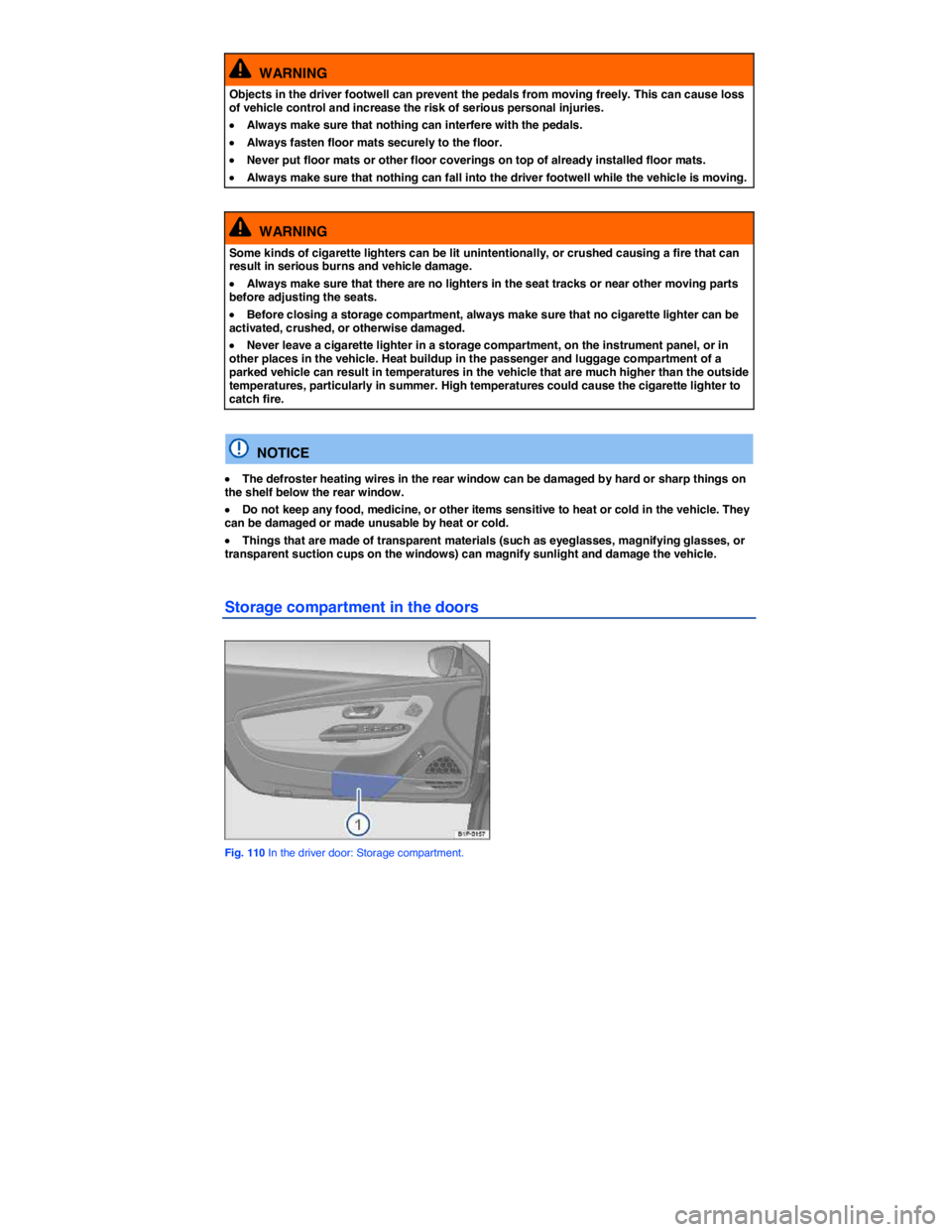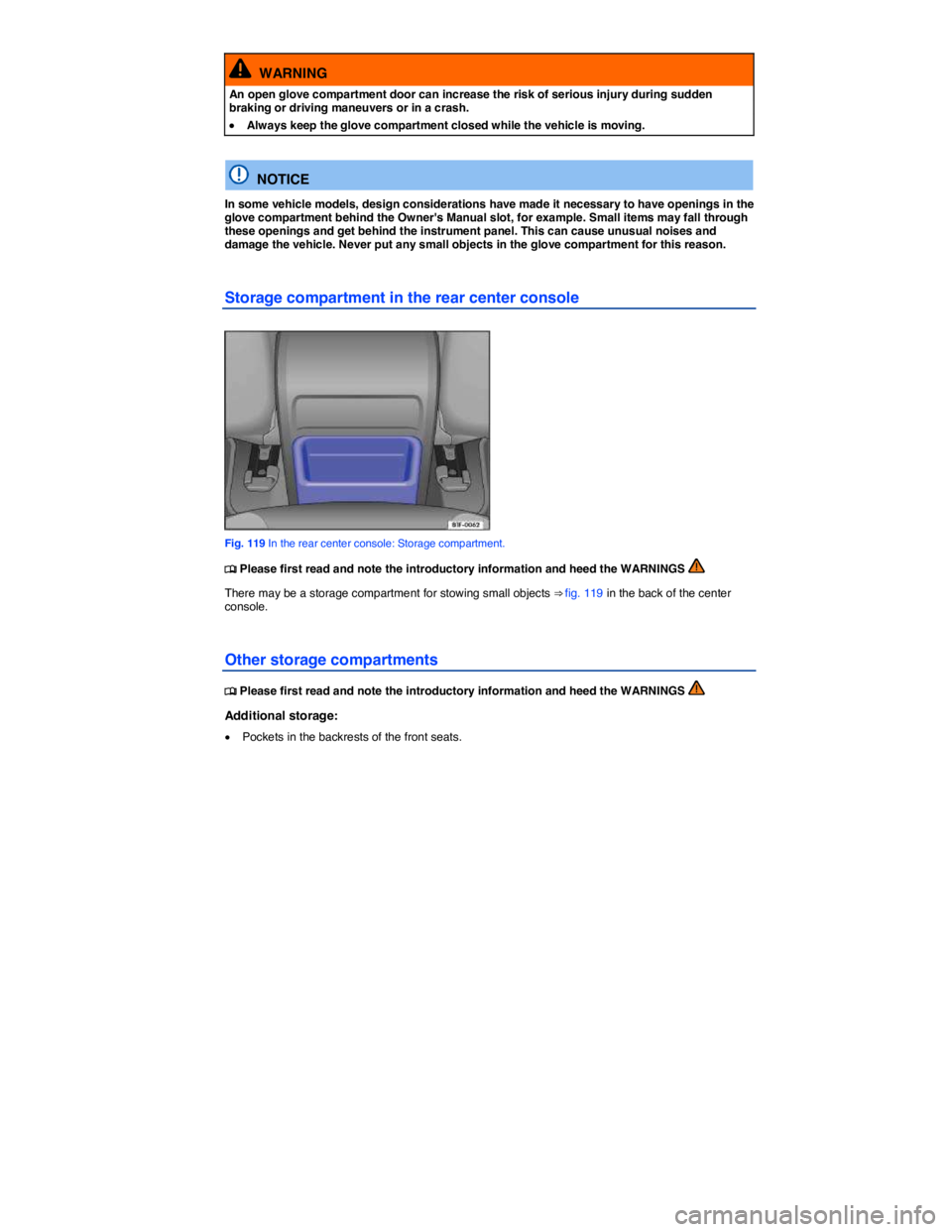2008 VOLKSWAGEN EOS door
[x] Cancel search: doorPage 137 of 381

WARNING
Unsecured or incorrectly stowed items can fly through the vehicle, causing serious personal injury during hard braking or sharp steering or in an accident. Loose items can also be struck and thrown through the passenger compartment by the front airbags if they inflate. To help reduce the risk of serious personal injury:
�x Always stow all objects securely in the vehicle. Always put luggage and heavy items in the luggage compartment.
�x Always secure objects in the passenger compartment properly with suitable straps so that they cannot move into the deployment zone of a side or front airbag during sudden braking, in a sudden maneuver, or in a collision.
�x Always keep storage compartments closed while driving.
�x Never stow hard, heavy, or sharp objects in the vehicle's open storage compartments, on the shelf behind the rear seat bench, or on the top of the instrument panel.
�x Always remove hard, heavy, or sharp objects from clothing and bags in the vehicle interior and stow them securely in the luggage compartment.
WARNING
Transporting heavy objects causes the handling characteristics of the vehicle to change and increases braking distances. Heavy loads which are not properly stowed or secured in the vehicle can lead to a loss of vehicle control and cause serious personal injury.
�x Transporting heavy items causes the handling characteristics of the vehicle to change by shifting the vehicle's center of gravity.
�x Always distribute luggage evenly and as low as possible within the vehicle. The vehicle capacity weight figures apply when the load is distributed evenly in the vehicle (passengers and luggage).
�x Always stow luggage and heavy items in the luggage compartment as far forward of the rear axle as possible and secure them with appropriate straps.
�x Never exceed the vehicle's Gross Vehicle Weight Rating or Gross Axle Weight Ratings, which are printed on the Safety Compliance Certification Label located on the door jamb of the driver door. Exceeding the permissible weight can cause the vehicle to skid and behave differently.
�x Always adapt your speed and driving style to accommodate your payload and its weight distribution within your vehicle.
�x Be especially cautious and gentle when stepping on the accelerator pedal and avoid sudden braking and other maneuvers.
�x Brake earlier than you would if you were not driving a loaded vehicle.
NOTICE
The defroster heating wires in the rear window can be damaged by objects that rub against them.
Page 158 of 381

WARNING
Tires must have the required clearance. Tires that do not have enough clearance can rub against parts of the vehicle body, suspension, and brake system, causing brake system failure, tread delamination, and sudden blowouts.
�x Always make sure that new tires are not larger than the tires approved for your vehicle and that the new tires do not rub against parts of the vehicle.
NOTICE
�x When switching to different tires, make certain the valves and sensors are not damaged.
�x Never drive without valve stem caps. The valves and sensors of the Tire Pressure Monitoring System could be damaged.
�x If the sensor on the Tire Pressure Monitoring System must be replaced, the valve must be replaced at the same time.
Always dispose of old tires in accordance with legal requirements.
TPMS wheel sensors are classified as Perchlorate Material – Special handling may apply. Obey all legal requirements regarding handling and disposal of these components – see http://www.dtsc.ca.gov/hazardouswaste/perchlorate. Obey all applicable legal requirements regarding handling and disposal of the vehicle or parts of its restraint system, including airbag modules and safety belts with pretensioners. Authorized Volkswagen dealers and authorized Volkswagen Service Facilities are familiar with the requirements, and we recommend that you have them perform this service for you.
If the replacement wheel is different from the tires that you have mounted on your vehicle (for example: winter tires; wider, low-profile tires; or a compact spare), then use the replacement wheel for a short time only, and drive cautiously.
�x Replace it with a tire matching the others on your vehicle as soon as possible.
Although tire size specifications can be the same, the actual dimensions may differ from those nominal values for different tire makes, or the tire contours may be significantly different.
Tire inflation pressure
Fig. 104 On the driver door jamb: Location of the tire inflation pressure label.
Page 173 of 381

Sidewall separation
The parting of the rubber compound from the cord material in the sidewall.
Speed rating (letter code)
A standardized letter code indicating the maximum speed at which a tire is designed to be driven for extended periods of time. The ratings range from 93 mph or 150 km/h (“P”) to 186 mph or (300 km/h) “Y”.
The speed rating letter code, where applicable, is molded on the tire sidewall ⇒ page 249, Speed rating code letter. You may not find this information on all tires because it is not required by law.
Tire Pressure Monitoring System
A system that detects when at least one of a vehicle's tires is underinflated and illuminates a low tire-pressure warning light.
Tread
The portion of a tire that normally touches the road.
Tread rib
A tread section running circumferentially around a tire.
Tread separation
Tire failure caused by the tread pulling away from the tire carcass.
Tread wear indicators (TWI)
Raised areas within the main tread grooves that show, visually, when tires are worn and near the end of their useful life, Tread depth and tread wear indicators.
Uniform Tire Quality Grading (UTQG)
A tire information system developed by the U.S. National Highway Traffic Safety Administration (NHTSA) that is designed to help buyers compare tires. UTQG is not a safety rating, nor is it a guarantee that a tire will last for a certain number of miles or perform a certain way. It gives tire buyers more information to compare with factors such as price, brand loyalty and dealer recommendations. Under UTQG, tires are graded by the tire manufacturers in 3 areas: tread wear, traction and temperature resistance. UTQG information is molded into the tire sidewalls.
U.S. DOT Tire Identification Number (TIN)
A tire's serial number. It begins with the letters “DOT” (“Department of Transportation”) and indicates that the tire meets all federal standards. The next 2 numbers or letters indicate the plant where the tire was manufactured. The last 4 numbers represent the week and year of manufacture.
For example, the numbers 1709 mean that the tire was produced in the 17th week of 2009. Any other numbers are marketing codes used by the tire manufacturer. This information is used to help identify affected consumers if a tire defect requires a recall.
Vehicle capacity weight
The total rated cargo, luggage and passenger load. Passenger load is 150 lbs (68 kilograms) times the vehicle's total seating capacity (as listed on the label inside the driver door).
Vehicle maximum load on the tire
The load on an individual tire that is determined by taking each axle's share of the maximum loaded vehicle weight (GAWR) and dividing by 2.
Page 176 of 381

�x Temperature: A, B or C
For example: Treadwear 200, Traction AA, Temperature A.
All passenger car tires must conform to Federal Safety Requirements in addition to these grades.
Treadwear
The treadwear grade is a comparative rating based on the wear rate of the tire when tested under controlled conditions on a specified government test course.
For example, a tire graded 150 (Treadwear-value 150) would wear one-and-one-half (1 1/2) times as well on the government course as a tire graded 100.
The relative performance of tires depends upon the actual conditions of their use, however, and may depart significantly from the norm due to variations in driving habits, service practices and differences in road characteristics and climate.
Traction
The traction grades, from highest to lowest, are AA, A, B and C. Those grades represent the tire's ability to stop on wet pavement as measured under controlled conditions on specified government test
surfaces of asphalt and concrete. A tire marked C may have poor traction performance ⇒ .
Temperature
The temperature grades are A (the highest), B, and C representing the tire's resistance to the generation of heat, and its ability to dissipate heat when tested under controlled conditions on a specified indoor laboratory test wheel.
Sustained high temperature can cause the material of the tire to degenerate and reduce tire life, and excessive temperature can lead to sudden tire failure.
The grade C corresponds to a level of performance which all passenger car tires must meet under the Federal Motor Vehicle Safety Standard No. 109. Grades B and A represent higher levels of
performance on the laboratory test wheel than the minimum required by law ⇒ .
WARNING
The traction grade assigned to this tire is based on straight-ahead braking traction tests, and does not include acceleration, cornering, hydroplaning or peak traction characteristics.
WARNING
The temperature grade for this tire is established for a tire that is properly inflated and not overloaded. Excessive speed, underinflation or excessive loading, either separately or in combination, can cause heat buildup and possible tire failure.
Page 178 of 381

WARNING
Incorrect tire pressures and/or underinflation can cause sudden tire failure, loss of control, collision, serious personal injury or even death.
�x When the warning symbol appears in the instrument cluster, stop and inspect the tires.
�x Incorrect tire pressure and/or underinflation can cause increased tire wear and can affect the handling of the vehicle and stopping ability.
�x Incorrect tire pressures and/or underinflation can also lead to sudden tire failure, including a blowout and sudden deflation, causing loss of vehicle control.
�x The driver is responsible for the correct tire pressures for all tires on the vehicle. The recommended tire pressure values are listed on a sticker inside the driver door, Tire inflation pressure.
�x The TPMS can only work correctly when all tires on the vehicle are filled to the correct cold tire inflation pressure specified for the tires installed on the vehicle.
�x Using incorrect tire pressure values can cause accidents or other damage. Always inflate the tires to the correct specified cold tire pressure values for the tires installed on the vehicle.
�x Always maintain correct cold tire inflation pressure so that TPMS can do its job.
�x Always inflate tires to the recommended and correct tire pressure before driving off.
�x Driving with underinflated tires causes them to flex (bend) more, letting them get too hot, resulting in tread separation, sudden tire failure and loss of control.
�x Excessive speed and/overloading can cause heat build-up, sudden tire failure, and loss of control.
�x If the tire pressure is too low or too high, the tires will wear prematurely and the vehicle will not handle well.
�x If the tire is not “flat” and you do not have to change a wheel immediately, drive carefully and at reduced speed to the nearest service station to check the tire pressure and add air as required.
�x When replacing tires or wheel rims on vehicles equipped with TPMS always read and heed the information and all WARNINGS regarding Tires and wheels, Tires and wheels.
NOTICE
�x The wheel electronics are attached to special aluminum valves on the wheels. These valves are screwed on rigidly. Never bend the valves “into position” when checking and adjusting tire pressure.
�x Missing valve stem caps can cause damage to the valves as well as to the TPMS sensors. To help prevent damage, always use valve stem caps like those originally installed at the factory. The caps must be screwed on tightly. Do not use metal valve stem caps.
�x Do not use “comfort valve caps.” They do not seal properly and can damage the sensors.
�x When replacing or rotating tires, make certain the valves and sensors are not damaged.
�x The aluminum valves that are installed should be replaced after about 6 years of use because of aging in the rubber seals. The valves can be replaced when a tire is changed. Do not reuse aluminum valves after they are removed. They must be replaced. The tire pressure sensor can be reused.
�x When replacing the valve cores, use only nickel-plated replacement cores.
�x The batteries in the wheel electronics last up to 10 years. It is not possible to replace the batteries. The entire device must be replaced.
Underinflation increases fuel consumption and tire wear.
Page 179 of 381

Dispose of the wheel electronics and the old batteries in an environmentally responsible manner. Batteries of the type used in the wheel electronics may contain Perchlorate Material. Special handling may apply. See www.dtsc.ca.gov/hadardouswaste/perchlorate. Obey all applicable legal requirements regarding proper disposal.
Do not rely only on the Tire Pressure Monitoring System. Check your tires regularly to make sure they are properly inflated and have no signs of damage, such as punctures, cuts, cracks, and blisters. Remove any objects that become embedded in the tire tread but have not penetrated into the body of tire itself.
The Tire Pressure Monitoring System checks for the factory-recommended inflation pressure, as shown on the label inside the driver door, Tire inflation pressure.
�x For replacement tires that require a different inflation pressure, the TPMS must be adjusted to the new pressure specification by an authorized Volkswagen dealer or an authorized Volkswagen Service Facility. Only one value can be entered for each tire; see the tire inflation pressure label on the driver
door pillar ⇒ page 240, Tire inflation pressure.
�x To help prevent damage to the sensor and valve, do not put excessive force on the valve when checking the tire pressure. Do not try to bend the valve.
�x If sensors have to be replaced, have the valves changed at the same time.
�x The tire valve gaskets must be replaced whenever a tire is mounted on the rim. Your authorized Volkswagen dealer or authorized Volkswagen Service Facility has a valve seal and gasket kit for this purpose. Always make sure that a valve seal and gasket kit is also used whenever a sensor is replaced.
�x If you have to adjust the tire pressure on a “warm” tire, fill the tire with 2.0 - 4.35 psi (20 - 30 kPa) more than the pressure specified on the tire pressure label.
�x When the TPMS determines that the air pressure in at least one tire is too low, carefully check the pressure in all 4 tires with an accurate tire pressure gauge. Low tire pressure usually cannot be determined by looking at the tire. This is especially true of low-profile tires.
A Declaration of Compliance with the United States FCC and Industry Canada regulations is found in the Consumer Information section of this Manual, Declaration of Compliance, Telecommunications and Electronic Systems.
There may be differences between the pressure readings from a tire pressure gauge and the pressures registered by the Tire Pressure Monitoring System. The electronic TPMS is more accurate.
If you have work done on your wheels or tires, inform the workshop that the vehicle is equipped with a Tire Pressure Monitoring System that has sensors in the wheels.
Indicator light (telltale) �
Page 185 of 381

WARNING
Objects in the driver footwell can prevent the pedals from moving freely. This can cause loss of vehicle control and increase the risk of serious personal injuries.
�x Always make sure that nothing can interfere with the pedals.
�x Always fasten floor mats securely to the floor.
�x Never put floor mats or other floor coverings on top of already installed floor mats.
�x Always make sure that nothing can fall into the driver footwell while the vehicle is moving.
WARNING
Some kinds of cigarette lighters can be lit unintentionally, or crushed causing a fire that can result in serious burns and vehicle damage.
�x Always make sure that there are no lighters in the seat tracks or near other moving parts before adjusting the seats.
�x Before closing a storage compartment, always make sure that no cigarette lighter can be activated, crushed, or otherwise damaged.
�x Never leave a cigarette lighter in a storage compartment, on the instrument panel, or in other places in the vehicle. Heat buildup in the passenger and luggage compartment of a parked vehicle can result in temperatures in the vehicle that are much higher than the outside temperatures, particularly in summer. High temperatures could cause the cigarette lighter to catch fire.
NOTICE
�x The defroster heating wires in the rear window can be damaged by hard or sharp things on the shelf below the rear window.
�x Do not keep any food, medicine, or other items sensitive to heat or cold in the vehicle. They can be damaged or made unusable by heat or cold.
�x Things that are made of transparent materials (such as eyeglasses, magnifying glasses, or transparent suction cups on the windows) can magnify sunlight and damage the vehicle.
Storage compartment in the doors
Fig. 110 In the driver door: Storage compartment.
Page 189 of 381

WARNING
An open glove compartment door can increase the risk of serious injury during sudden braking or driving maneuvers or in a crash.
�x Always keep the glove compartment closed while the vehicle is moving.
NOTICE
In some vehicle models, design considerations have made it necessary to have openings in the glove compartment behind the Owner's Manual slot, for example. Small items may fall through these openings and get behind the instrument panel. This can cause unusual noises and damage the vehicle. Never put any small objects in the glove compartment for this reason.
Storage compartment in the rear center console
Fig. 119 In the rear center console: Storage compartment.
�